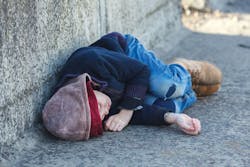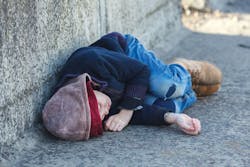An appeal for your help
The challenge of your career should include advocacy for dental care for all
Betty Peebles, RDH
Would you like to feel that you are making a real difference for your patients and your community?
You likely chose health care as a profession for this reason. However, most of us graduate full of energy and commitments only to find that our jobs are repetitive and lack the challenge and growth we want. Our profession can be lonely in so many ways. It can be hard to stay connected with one another because we are busy and have other important commitments. That is understood. It’s the way it has always been. It tends to be what keeps us in dead-end jobs, with no upward mobility and a sense of general dissatisfaction. I have news for you, my friends: The times are changing. It is only within the last few years that I came to realize this, and I now want to share what I have learned.
Oral health and the lack of access to care is one of the leading public health issues in the world. Why didn’t I realize this until recently? The answer is that we don’t talk about it enough in our schools, in our associations, or in any of our conversations.
Many of us think of dental care as what we see every day in our dental offices, completely unaware that dentistry has another context for millions of people. In the United States, if you can’t pay for care, you simply may not receive it. That is unacceptable.
As professionals, we are stewards of oral health. It is the career we have chosen and by doing so, we own this problem. The responsibility is ours to represent the public by fighting to improve the access and quality of care for everyone. That’s not boring; that’s a challenge!
© Roman Bodnarchuk | Dreamstime.com
The Big Error
How did we get to this point?
Mary Otto’s book, Teeth, explains how our profession was born. In the 1840s, there was a divide between physicians and dentists. Physicians were in the process of adding dental education to the College of Medicine at the University of Maryland. Although dentists wished to be included, they were denied in a letter that said the subject of dentistry was of little consequence. Because of that initial separation, dentistry and traditional medicine have been on different paths for the last 178 years.(1)
This is a critical point to understand. In most states today, the complete human body is covered by public or private insurance, except for the oral cavity. We know that diseases of the mouth influence our general health, but a mistake was made. A bad decision. A decision that has continued to cause deep human suffering and death. At its core, this is a public policy failure, a mistake of history that can and must be corrected.
The result of this mistake causes harm today
In a school near you, kids show up each day with dental pain. They need treatment, sealants, and education. In hospitals across the country, thousands of people present each year with severe dental pain and disease. Because there are no dentists in the hospitals, people are typically turned away with pain medication, an antibiotic, and still in pain.
The homeless and senior citizens are in desperate need of care. However, the working poor are particularly hard hit because, even though they work, they cannot afford a dental visit. They could be someone who you see every day, such as your pizza delivery person, retail store clerk, or child-care provider. Once you start to notice the people in your community with poor oral health, you will see them everywhere.
Role of poverty
We know dental disease is preventable. It just takes education, a healthy diet, and dental care—`things that the poor do not have. The problem is fundamentally tied to poverty and the lack of Medicaid or Medicare to adequately pay for treatment.
In a recent Washington Post article, Premilla Nadasen, a teacher at Barnard College, states that the “shredding of the safety net” and the funding for education and public programs has declined, and the poor have been hit the hardest. She quotes Philip Alston, the United Nations expert on extreme poverty and human rights.(2) Alston recently completed a 15-day tour of the United States. He visited Alabama, California, Puerto Rico, West Virginia, and Washington, D.C. In his findings, he documented homelessness and unsafe sanitation, as well as criminalization and harassment of the poor. The rise in poverty was found to “disproportionately affect people of color” but also a “large swath of white Americans.” The report concluded that “the pervasiveness of poverty and inequity are shockingly at odds [with the United States’] immense wealth and its founding commitment to human rights.”
So if the United Nations finds growing numbers of Americans are living in impoverished circumstances, what does that mean exactly? For example, in 2018, the US Federal Poverty Guidelines used to determine financial eligibility for federal assistance are:
- For one person, annual income cannot exceed $12,140.
- For four people, annual income cannot exceed $25,100.(3)
It is no surprise that homelessness is growing throughout the country, and tent cities are popping up everywhere. It is the children who are hurt the most, since their bodies and teeth are forming and developing without being given enough food and without appropriate care.
Figures published by the National Center for Children in 2017 indicated 41% of children were low income and 19% were poor.(4) This means that children are overrepresented among our nation’s poor. Children represented 23% of our population, but comprise 32% of all people in poverty.(5)
In the year 2000, the former US surgeon general, Dr. David Satcher, announced a national call to action to promote oral health and presented an exhaustive report that documented the need.
Dr. Satcher said, “The report was a wake-up call, raising a powerful voice against the silence. No school child should suffer the stigma of craniofacial birth defects nor be found unable to concentrate because of the pain of untreated oral infections. No rural inhabitant, no homebound adult, no inner-city dweller should experience poor oral health because of barriers to access to care and shortages of resources and personnel.”(6)
The search for solutions
The report asked for solutions by 2020. We know the original effort sparked many to join the battle. DentaQuest was among them. The DentaQuest Foundation has invested in a national network of over 1,000 people who share a vision of “oral health for all.” You should join to connect with people and access tools and resources available at dentaquestfoundation.org. This is a powerful resource for anyone working on this problem.
Another large organization working on these issues is Oral Health America (OralHealthAmerica.org). They are doing wonderful work. Check out their website for the recently released “State of Decay” report. This report studies the key impact of poor oral health on older adults across the country.
There is so much more that needs to be done! This issue needs increased awareness by professionals, the public, and political leaders. We need this fight to be as visible as possible to combat problems that thrive on isolation and silence. We need printed articles and social media to raise the conversation. If we don’t talk about it, who will?
So, what can you do?
Anything involving poverty, housing, education, employment, and public policy is a complex problem. We can’t solve all of the issues, but we can work together on the oral health part.
If you have a special interest in children or the elderly, the handicapped or the homeless, look for groups working in that area in your community. If there are no existing programs, consider starting something yourself. Talk to your patients, your PTA, your book club, or your public representative. Join your national organization to help fight for a change. The Jon C. Burr Foundation will be happy to help with any questions. Send us an email, and we will get back to you as quickly as possible.
Change is coming, and you need to be part of it. Few of us think of ourselves as leaders. In fact, our profession never provided a great deal of opportunity for leadership growth until now. Step up. There are approximately 200,000 of us. We are a force for the health of our fellow citizens and our country.
We know that poor oral health causes poor general health, and people with bad oral health can’t find jobs. You can help. Please join us and rise to the challenge!
Editor’s note:References are available below in the online version of this article at RDHmag.com.
References
1. Otto M. Teeth: The Story of Beauty, Inequality, and the Struggle for Oral Health in America. The Birth of American Dentistry. New York Press, New York. 2016:94.
2. Nadasen P. Extreme Poverty Returns to America. Washington Post. December 21, 2017.
3. Poverty Guidelines. US Department of Health and Human Services. Office of the Assistant Secretary for Planning and Evaluation. ASPE website. https://aspe.hhs.gov/2017-poverty-guidelines. Accessed September 28, 2018.
4. Child Poverty. National Center for Children in Poverty website. http://www.nccp.org/topics/childpoverty.html. Published 2018. Accessed September 28, 2018.
5. Poverty in the United States. Wikipedia website. https://en.wikipedia.org/wiki/Poverty_in_the_United_States. Updated September 26, 2018. Accessed September 28, 2018.
6. Oral Health in America: A Report of the Surgeon General. US Department of Health and Human Services National Institute of Dental and Craniofacial Research, National Institutes of Health. 2000. Preface by David Satcher, MD, PhD.


